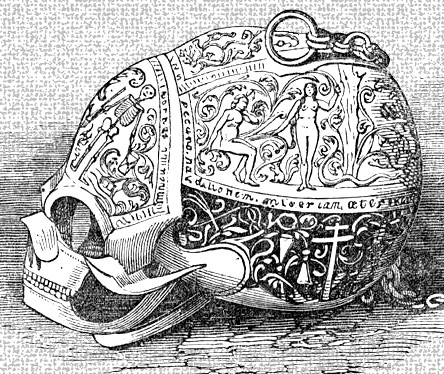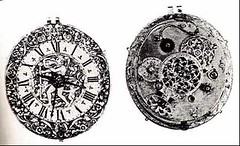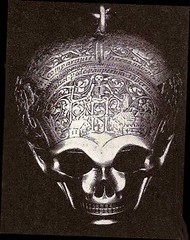When I was a youngster in the 1960s, two watches I really wanted to see or own were the so-called Nuremburg Egg (actually a misnomer) and the Seaton Watch (see below). The Nuremburg Egg was the earliest portable clocks made. Along side that, I wanted a skull watch. Not just any Victorian skull watch, which are expensive but available, I wanted the Seaton Watch. I always set my sights high.
The Seaton Watch was made for Mary Queen of Scots in the late 1500s by Moyant A. Bolis circa the late 1500s and given by the Queen to Mary to Mary Setoun, one of her Maids of Honor. It wasn’t actually made to be worn around the neck, being fairly heavy, but was fully portable and could be suspended by the chain on a table, prie-dieu or altar. It also has a leather form-fitting case to cover the watch when not in use.
The silver skull watch was a memento mori to remind the viewer of the transient nature of Earthy time. The watch had only an hour hand and could be viewed by opening the jaw, which exposed the face of the watch. The time was marked audibly by a small bell, which was struck on the hour. The best overall write-up of this rare watch was in Godey’s Lady’s Book, March 1850, which was a major woman’s fashion book of the era. Rather than rehash the very detailed description from a difficult to find, 160 year old source, I have simply placed it on the blog:

"On the forehead of the skull is the figure of Death, with his scythe and sand-glass. He stands between a palace on one hand and a cottage on the other, with his toes applied equally to the door of each; and around this is the legend from Horace, 'Pallida mors aequo pulsat pede pauperum tabernas Regumque turres.' On the opposite, or posterior part of the skull, is a representation of Time devouring all things. He also has a scythe: and near him is the serpent with its tail in its mouth, being an emblem of eternity. This is surrounded by another legend from Horace – ' Tempus edax rerum tuque invidiosa vetustas.' The upper part of the skull is divided into two compartments: on one are represented our first parents in the Garden of Eden, attended by some of the animals, with the motto, ' Peccando perditionem miseriam aeternam posteris meruere.' The opposite compartment is filled with the subject of the salvation of lost man by the crucifixion of our Saviour, who is represented as suffering between the two thieves, whilst the Marys are in adoration below: the motto to this is ' Sic justitiae satisfecit, mortem superavit, salutem comparavit.' Running below these compartments, on both sides, there is an open-work of about an inch in width, to permit the sound to come more fully when the watch strikes. This is formed of emblems belonging to the crucifixion – scourges, of various kinds; ,:words; the flagon and cup of the eucharist; the cross; pincers; lantern used in the garden; spears, of different kinds, and one with the sponge on its point; thongs; ladder; the coat without a seam, and the dice that were thrown for it; the hammer and nails, and the crown of thorns. Under all these is the motto, 'Scala caeli ad gloriam via.'

"The watch is opened by reversing the skull, and placing the upper part of it in the hollow of the hand, and then lifting the under jaw, which rises on a hinge. Inside, on the plate, which may thus be called the lid, is a representation of the Holy Family in the stable, with the infant Jesus laid in the manger, and angels ministering to him; in the upper part, an angel is seen descending, with a scroll, on which is written ' Gloria excelsis Deo, et in terra, pax, hominibus bona volu.' In the distance are the shepherds, with their flocks; and one of the men is in the act of performing on a cornemuse.
 The works of the watch occupy the position of the brains in the skull itself; the dial-plate being on a flat where the roof of the mouth and the parts behind it, under the base of the brain, are to be found in the real subject. The dial-plate is of silver, and is fixed within a golden circle, richly carved in a scroll pattern. The hours are marked in large Roman letters; and within them is the figure of Saturn devouring his children, with this relative legend round the outer rim of the flat, ' Sicut meis sic et omnibus idem.' Lifting up the body of the works on the hinges by which they are attached, they are found to be wonderfully entire. There is no date; but the maker's name, with the place of manufacture, ' Moyse, Blois,' are distinctly engraven. Blois is the place where it is believed that. watches were first made; and this suggests the probability of the opinion that the watch was expressly ordered by Queen Mary, at Blois, when she went there with her husband, the dauphin, previous to his death.
The works of the watch occupy the position of the brains in the skull itself; the dial-plate being on a flat where the roof of the mouth and the parts behind it, under the base of the brain, are to be found in the real subject. The dial-plate is of silver, and is fixed within a golden circle, richly carved in a scroll pattern. The hours are marked in large Roman letters; and within them is the figure of Saturn devouring his children, with this relative legend round the outer rim of the flat, ' Sicut meis sic et omnibus idem.' Lifting up the body of the works on the hinges by which they are attached, they are found to be wonderfully entire. There is no date; but the maker's name, with the place of manufacture, ' Moyse, Blois,' are distinctly engraven. Blois is the place where it is believed that. watches were first made; and this suggests the probability of the opinion that the watch was expressly ordered by Queen Mary, at Blois, when she went there with her husband, the dauphin, previous to his death. The watch appears to have been originally constructed with catgut, instead of chain, which it now has, which must have been a more modern addition. It is now in perfect order, and performs wonderfully well, though it requires to be wound up within twenty-six hours to keep it going with tolerable accuracy. A large silver bell, of very musical sound, fills the entire hollow of the. skull, and receives the works within it when the watch is shut. A small hammer, set in motion by a separate escapement, strikes the hours on it.

"This very curious relic must have then intended to occupy a stationary place on a prie-dieu, or small altar, in a private oratory; for its weight is much too great to have admitted of its being carried in any way attached to the person."
“This watch is in the possession of Sir T. D. Lauder family, of Grange and Fountain Hall, Bart, who inherited it through the Setoun family, from which they are descended; it having been given by Queen Mary to Mary Setoun, of the house of Wintoun, one of the four Marys, Maids of Honor to the Scottish Queen.”
UPDATE: This homological wonder has been traveling throughout the world visiting such museums as the Taft Museum of Art, The Walters Museum, Munson-Williams-Proctor Arts Institute, and the British Museum. I don’t know its present whereabouts, however.
Sadly, the original movement has been modified some 250 plus years ago with the added minute hand, however the face is original in this 400 year old watch. I never got a Nuremburg Egg nor the Seaton Watch, but I’m not giving up hope.
You can download a copyright free edition of Smith’s Historical and Literary Curiosities here. Although skull watches are not part of H. P. Lovecraft’s Cthulhu Mythos, they are a great prop for the RPG. Stay tuned for the second part of Skull Watches, which I will post later on. This would also be great for Steampunk and other gamer's resources.

No comments:
Post a Comment